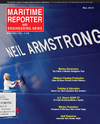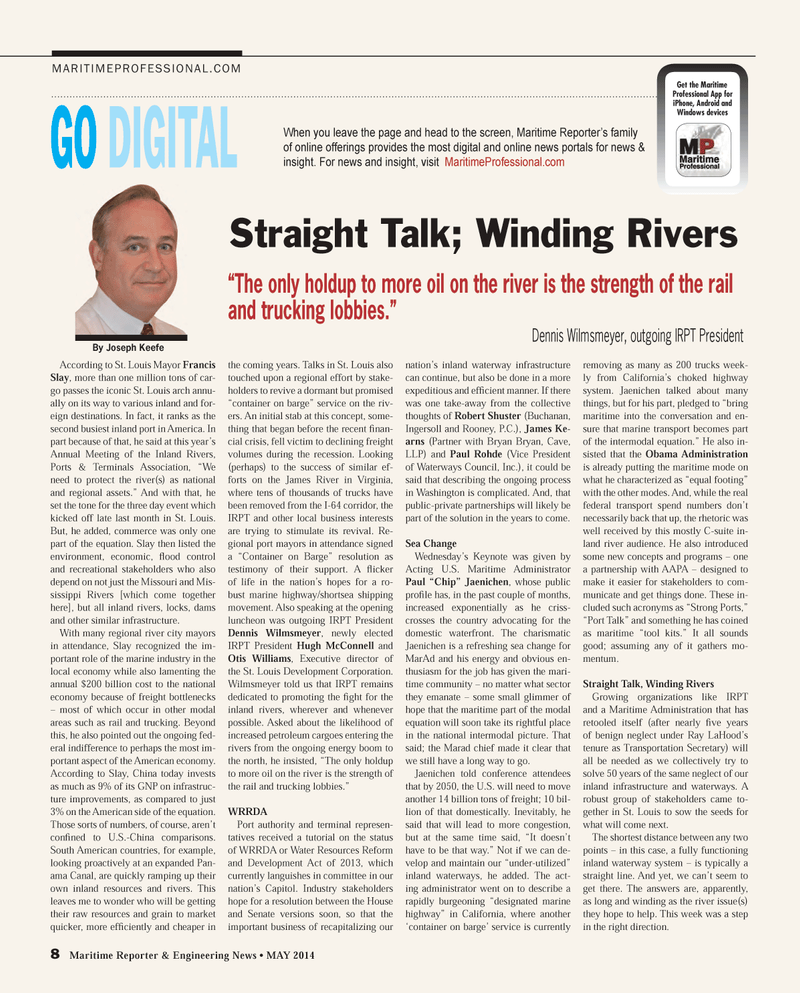
Page 8: of Maritime Reporter Magazine (May 2014)
Marine Electronics Edition
Read this page in Pdf, Flash or Html5 edition of May 2014 Maritime Reporter Magazine
According to St. Louis Mayor Francis
Slay, more than one million tons of car- go passes the iconic St. Louis arch annu- ally on its way to various inland and for- eign destinations. In fact, it ranks as the second busiest inland port in America. In part because of that, he said at this year’s
Annual Meeting of the Inland Rivers,
Ports & Terminals Association, “We need to protect the river(s) as national and regional assets.” And with that, he set the tone for the three day event which kicked off late last month in St. Louis.
But, he added, commerce was only one part of the equation. Slay then listed the environment, economic, fl ood control and recreational stakeholders who also depend on not just the Missouri and Mis- sissippi Rivers [which come together here], but all inland rivers, locks, dams and other similar infrastructure.
With many regional river city mayors in attendance, Slay recognized the im- portant role of the marine industry in the local economy while also lamenting the annual $200 billion cost to the national economy because of freight bottlenecks – most of which occur in other modal areas such as rail and trucking. Beyond this, he also pointed out the ongoing fed- eral indifference to perhaps the most im- portant aspect of the American economy.
According to Slay, China today invests as much as 9% of its GNP on infrastruc- ture improvements, as compared to just 3% on the American side of the equation.
Those sorts of numbers, of course, aren’t confi ned to U.S.-China comparisons.
South American countries, for example, looking proactively at an expanded Pan- ama Canal, are quickly ramping up their own inland resources and rivers. This leaves me to wonder who will be getting their raw resources and grain to market quicker, more effi ciently and cheaper in the coming years. Talks in St. Louis also touched upon a regional effort by stake- holders to revive a dormant but promised “container on barge” service on the riv- ers. An initial stab at this concept, some- thing that began before the recent fi nan- cial crisis, fell victim to declining freight volumes during the recession. Looking (perhaps) to the success of similar ef- forts on the James River in Virginia, where tens of thousands of trucks have been removed from the I-64 corridor, the
IRPT and other local business interests are trying to stimulate its revival. Re- gional port mayors in attendance signed a “Container on Barge” resolution as testimony of their support. A fl icker of life in the nation’s hopes for a ro- bust marine highway/shortsea shipping movement. Also speaking at the opening luncheon was outgoing IRPT President
Dennis Wilmsmeyer, newly elected
IRPT President Hugh McConnell and
Otis Williams, Executive director of the St. Louis Development Corporation.
Wilmsmeyer told us that IRPT remains dedicated to promoting the fi ght for the inland rivers, wherever and whenever possible. Asked about the likelihood of increased petroleum cargoes entering the rivers from the ongoing energy boom to the north, he insisted, “The only holdup to more oil on the river is the strength of the rail and trucking lobbies.”
WRRDA
Port authority and terminal represen- tatives received a tutorial on the status of WRRDA or Water Resources Reform and Development Act of 2013, which currently languishes in committee in our nation’s Capitol. Industry stakeholders hope for a resolution between the House and Senate versions soon, so that the important business of recapitalizing our nation’s inland waterway infrastructure can continue, but also be done in a more expeditious and effi cient manner. If there was one take-away from the collective thoughts of Robert Shuster (Buchanan,
Ingersoll and Rooney, P.C.), James Ke- arns (Partner with Bryan Bryan, Cave,
LLP) and Paul Rohde (Vice President of Waterways Council, Inc.), it could be said that describing the ongoing process in Washington is complicated. And, that public-private partnerships will likely be part of the solution in the years to come.
Sea Change
Wednesday’s Keynote was given by
Acting U.S. Maritime Administrator
Paul “Chip” Jaenichen, whose public profi le has, in the past couple of months, increased exponentially as he criss- crosses the country advocating for the domestic waterfront. The charismatic
Jaenichen is a refreshing sea change for
MarAd and his energy and obvious en- thusiasm for the job has given the mari- time community – no matter what sector they emanate – some small glimmer of hope that the maritime part of the modal equation will soon take its rightful place in the national intermodal picture. That said; the Marad chief made it clear that we still have a long way to go.
Jaenichen told conference attendees that by 2050, the U.S. will need to move another 14 billion tons of freight; 10 bil- lion of that domestically. Inevitably, he said that will lead to more congestion, but at the same time said, “It doesn’t have to be that way.” Not if we can de- velop and maintain our “under-utilized” inland waterways, he added. The act- ing administrator went on to describe a rapidly burgeoning “designated marine highway” in California, where another ‘container on barge’ service is currently removing as many as 200 trucks week- ly from California’s choked highway system. Jaenichen talked about many things, but for his part, pledged to “bring maritime into the conversation and en- sure that marine transport becomes part of the intermodal equation.” He also in- sisted that the Obama Administration is already putting the maritime mode on what he characterized as “equal footing” with the other modes. And, while the real federal transport spend numbers don’t necessarily back that up, the rhetoric was well received by this mostly C-suite in- land river audience. He also introduced some new concepts and programs – one a partnership with AAPA – designed to make it easier for stakeholders to com- municate and get things done. These in- cluded such acronyms as “Strong Ports,” “Port Talk” and something he has coined as maritime “tool kits.” It all sounds good; assuming any of it gathers mo- mentum.
Straight Talk, Winding Rivers
Growing organizations like IRPT and a Maritime Administration that has retooled itself (after nearly fi ve years of benign neglect under Ray LaHood’s tenure as Transportation Secretary) will all be needed as we collectively try to solve 50 years of the same neglect of our inland infrastructure and waterways. A robust group of stakeholders came to- gether in St. Louis to sow the seeds for what will come next.
The shortest distance between any two points – in this case, a fully functioning inland waterway system – is typically a straight line. And yet, we can’t seem to get there. The answers are, apparently, as long and winding as the river issue(s) they hope to help. This week was a step in the right direction. 8 Maritime Reporter & Engineering News • MAY 2014
GO DIGITAL
Get the Maritime
Professional App for iPhone, Android and
Windows devices
MARITIMEPROFESSIONAL.COM
When you leave the page and head to the screen, Maritime Reporter’s family of online offerings provides the most digital and online news portals for news & insight. For news and insight, visit MaritimeProfessional.com
Straight Talk; Winding Rivers “The only holdup to more oil on the river is the strength of the rail and trucking lobbies.”
Dennis Wilmsmeyer, outgoing IRPT President
By Joseph Keefe
MR #5 (1-9).indd 8 5/1/2014 10:14:07 AM

 7
7

 9
9
